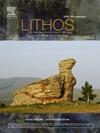镁铁同位素对岩石圈地幔在弧岩浆活动中的作用的约束
IF 2.5
2区 地球科学
Q2 GEOCHEMISTRY & GEOPHYSICS
引用次数: 0
摘要
弧岩浆作用通常被认为是通过俯冲成分和软流圈地幔楔的两端成岩过程产生的。弧下岩石圈地幔作为俯冲带重要的化学储层,对弧岩浆的贡献一直知之甚少。本文首次建立了巽他弧大陆弧玄武岩(CABs) MgFe同位素的系统数据集,用于解读弧下岩石圈地幔在弧岩浆活动中的作用。巽他岩浆岩δ26Mg值(- 0.28‰~ - 0.05‰)和δ56Fe值(- 0.19‰~ 0.14‰)变化显著,平均值分别为- 0.17‰和0.02‰,与全球弧岩浆相似。这些样品主要表现出较低的TiO2/Yb(0.3 ~ 0.5)和Fe/Mn(30 ~ 60)比值,表明它们来源于衰竭软流圈地幔楔内的橄榄岩熔融。Mg和Fe同位素与εNd的弱相关性表明,俯冲相关的交代作用对软流圈地幔楔的Mg和Fe同位素组成没有显著影响。大部分巽他岩浆δ26Mg与Fe/Mn呈负相关,δ56Fe与Fe/Mn呈正相关,这在全球弧岩浆中也有体现。弧内岩浆MgFe同位素和Fe/Mn比值的显著变化可能是由于它们通过不同比例的低铁/锰(30-50)辉石岩和高铁/锰(50-70)橄榄岩的合并与弧次岩石圈地幔的强烈相互作用所致。这种相互作用也可能提高了氧逸度,这一点可以从巽他岛弧玄武岩和弧玄武岩的MgFe同位素和V/Sc比值的共同变化中得到证明。因此,我们得出结论,亚弧岩石圈地幔在全球弧岩浆活动中起着至关重要的作用,而这在俯冲带岩浆活动的流行岩石成因模型中长期被忽视。本文章由计算机程序翻译,如有差异,请以英文原文为准。
Mg-Fe isotopic constraint on the role of the lithosphere mantle in arc magmatism
Arc magmatism is commonly envisaged as generation through a two-endmember petrogenetic process involving the subducted components and asthenospheric mantle wedge. The contribution of sub-arc lithospheric mantle, as a key chemical reservoir in subduction zone, to arc magmas remains poorly constrained. Here we present, for the first time, a systematic dataset of Mg![]() Fe isotopes on continental arc basalts (CABs) from the Sunda Arc for deciphering the role of sub-arc lithospheric mantle in arc magmatism. The Sunda CABs show significant variations in δ26Mg (−0.28 ‰ to −0.05 ‰) and δ56Fe values (−0.19 ‰ to 0.14 ‰), with mean values of −0.17 ‰ and 0.02 ‰, respectively, resembling those of global arc magmas. These samples mainly display low TiO2/Yb (0.3–0.5) and Fe/Mn (30–60) ratios, indicating their derivation from peridotite melting within the depleted asthenospheric mantle wedge. The weak correlations of Mg and Fe isotopes with εNd suggest that subduction-related metasomatism has not significantly influenced the Mg and Fe isotopic compositions of the asthenospheric mantle wedge. The majority of Sunda CABs exhibit a negative correlation between δ26Mg and Fe/Mn, as well as a positive correlation between δ56Fe and Fe/Mn, both also observed in global arc magmas. These significant variations in Mg
Fe isotopes on continental arc basalts (CABs) from the Sunda Arc for deciphering the role of sub-arc lithospheric mantle in arc magmatism. The Sunda CABs show significant variations in δ26Mg (−0.28 ‰ to −0.05 ‰) and δ56Fe values (−0.19 ‰ to 0.14 ‰), with mean values of −0.17 ‰ and 0.02 ‰, respectively, resembling those of global arc magmas. These samples mainly display low TiO2/Yb (0.3–0.5) and Fe/Mn (30–60) ratios, indicating their derivation from peridotite melting within the depleted asthenospheric mantle wedge. The weak correlations of Mg and Fe isotopes with εNd suggest that subduction-related metasomatism has not significantly influenced the Mg and Fe isotopic compositions of the asthenospheric mantle wedge. The majority of Sunda CABs exhibit a negative correlation between δ26Mg and Fe/Mn, as well as a positive correlation between δ56Fe and Fe/Mn, both also observed in global arc magmas. These significant variations in Mg![]() Fe isotopes and Fe/Mn ratios within arc magmas likely result from their intensive interactions with the sub-arc lithospheric mantle through incorporations of the low Fe/Mn (30–50) pyroxenite and high Fe/Mn (50–70) peridotite in different proportions. The interactions may have also elevated the oxygen fugacity as evidenced by the co-variations of Mg
Fe isotopes and Fe/Mn ratios within arc magmas likely result from their intensive interactions with the sub-arc lithospheric mantle through incorporations of the low Fe/Mn (30–50) pyroxenite and high Fe/Mn (50–70) peridotite in different proportions. The interactions may have also elevated the oxygen fugacity as evidenced by the co-variations of Mg![]() Fe isotopes and V/Sc ratios for the Sunda CABs and global arc basalts. We therefore conclude the crucial role played by the sub-arc lithospheric mantle in global arc magmatism, which has long been overlooked in popular petrogenetic models for subduction zone magmatism.
Fe isotopes and V/Sc ratios for the Sunda CABs and global arc basalts. We therefore conclude the crucial role played by the sub-arc lithospheric mantle in global arc magmatism, which has long been overlooked in popular petrogenetic models for subduction zone magmatism.
求助全文
通过发布文献求助,成功后即可免费获取论文全文。
去求助
来源期刊

Lithos
地学-地球化学与地球物理
CiteScore
6.80
自引率
11.40%
发文量
286
审稿时长
3.5 months
期刊介绍:
Lithos publishes original research papers on the petrology, geochemistry and petrogenesis of igneous and metamorphic rocks. Papers on mineralogy/mineral physics related to petrology and petrogenetic problems are also welcomed.
 求助内容:
求助内容: 应助结果提醒方式:
应助结果提醒方式:


